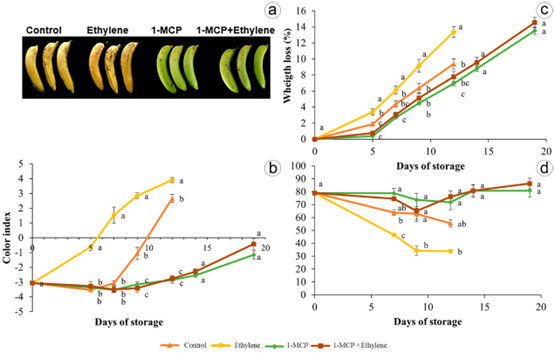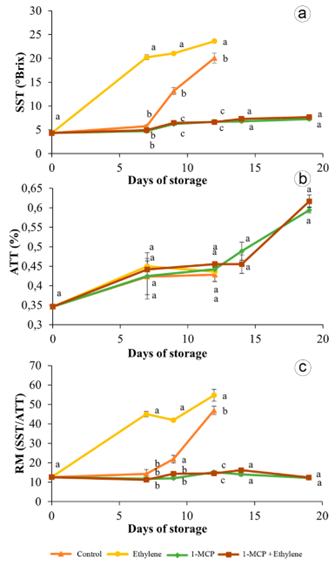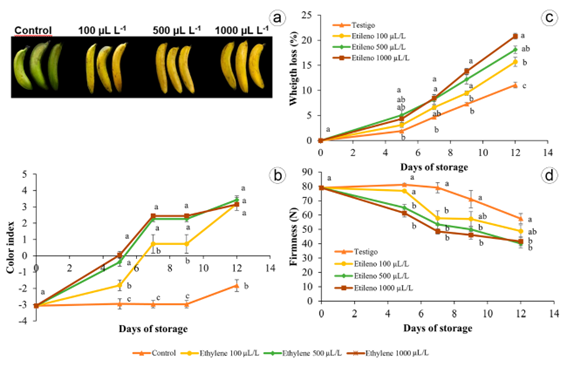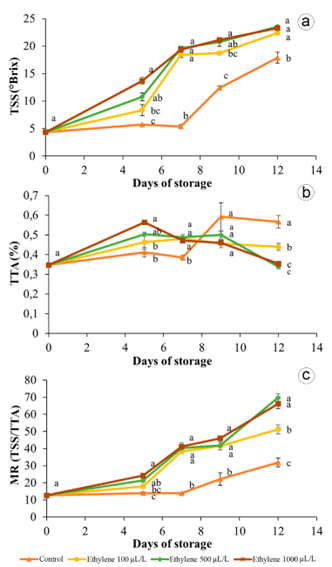INTRODUCTION
The banana (Musa acuminata, group AAA) is one of the most cultivated fruit crops in the world (Pérez & Torres-Bazurto, 2020). Banana is a tropical fruit with a high nutritional value that is widely consumed around the world because of its pleasant aroma and flavor (Khawas et al. 2014; Zhu et al. 2018). Colombia is one of the more important countries for banana export production. Antioquia, Magdalena, and La Guajira are the departments with the highest production in the country. In 2021, this country produced 2,413,769t in 101,890 ha, of which 2.103.076 t were exported (FAO, 2023). The banana is a typical climacteric fruit, and its ripening is closely associated with a strong increase in ethylene production (Zhu et al. 2015). It has a high respiratory rate after harvest, which makes it highly perishable and prone to postharvest losses (Brat et al. 2020).
One way to reduce postharvest losses of fruits is to know what processes are associated with ethylene during ripening, as a basis for the use of different technologies that reduce the biosynthesis and action of this hormone (Mariño-González et al. 2019). This is because ethylene is the hormone responsible for triggering physiological, biochemical, and molecular processes (An et al. 2020). Therefore, ethylene guarantees the ripening of different fruits but also induces senescence, an important cause of nutritional, physical and economic losses in agricultural products (Bapat et al. 2010; Pareek, 2016). Several studies have methodologically reported on applications of ethylene and 1-mecylcyclopropene (1-MCP) in climacteric fruits to determine the role of endogenous ethylene in ripening (Mariño-González et al. 2019; González et al. 2021), including in bananas (Golding et al. 1998; Zhu et al. 2015).
1-MCP is a maturity retardant that irreversibly occupies the membrane ethylene receptors and is the main inhibitor compound of the action of ethylene (In et al. 2013) but also inhibits the biosynthesis of this hormone (Balaguera-López et al. 2021). In banana cv. Fenjiao, 1-MCP decreased the activity of ethylene synthesis enzymes (Zhu et al. 2020). 1-MCP has important effects on delaying ripening in banana fruits (Botondi et al. 2014; Li et al. 2023). However, the concentration and timing of treatments could affect normal ripening (Zhu et al. 2015). Bananas treated with 1-MCP remained green or ripen with an uneven color (Harris et al. 2000). In banana cv. 'Brazil', a combination of 50 µL L-1 ethephon with 400 nL L-1 1-MCP (16 h) was the most appropriate treatment, which significantly delayed ripening and maintained the commercial value of the fruits without negatively affecting normal ripening (Zhu et al. 2015).
On the other hand, bananas are commonly harvested at commercial maturity, in a pre-climacteric phase, just before ripening begins. For this reason, artificial ripening treatments with exogenous ethylene are often necessary to ensure that bananas have an ideal yellow color and are ready to eat in local and export markets (Pongprasert et al. 2020). The effects of ethylene involve both the synthesis and accumulation of pigments, such as anthocyanins and carotenoids, and the decomposition of chlorophyll; the latter is critical in industrial treatments for the degreening of various fruit, crops such as citrus, banana and mango before marketing (Xie et al. 2016; (Li et al. 2019a). However, this process is unknown in cv. Barranquillo, a material with very good productive and quality characteristics.
Therefore, this research aimed: a) to study the effect of applications of 1-MCP and ethylene on the postharvest ripening process and b) to evaluate the effectiveness of different concentrations of ethylene on the degreening process in banana fruits cv. Barranquillo (Musa acuminata, AAA, ’Gros Michel’).
MATERIALS AND METHODS
Plant material and location. The study was carried out in the Plant Physiology laboratory of the Faculty of Agricultural Sciences of the Pedagogical and Technology University of Colombia, Tunja-Boyacá. 160 fruits (182 ± 7.9 g) without phytosanitary or mechanical damage were collected at harvest maturity (color index of -3.06) from commercial bananas cv. Barranquillo (Musa acuminata, AAA, 'Gros Michel ') in the municipality of Miraflores-Boyacá, coordinates 5°11’49” N and 73°8’47’’ W, located at an altitude of 1432m a.s.l. with an average temperature of 24 °C.
Experiment 1. Effect of 1-MCP and ethylene. The fruits were separated into 4 groups: T1: control without applications, T2: Ethylene (1000 µL L-1), T3: 1-MCP (0.35 mg L-1), and T4: 1-MCP (0.35 mg L-1) + Ethylene (1000 µL L-1). This experiment was carried out with a completely randomized design with 4 repetitions, and each experimental unit consisted of 5 fruits.
For the ethylene applications, 3 L containers were used, in which the required solution was prepared from ethephon commercial formula of 48 % and the fruits were left immersed for 10 minutes. The 1-MCP was applied in liquid form with the same immersion time. After the treatments, the fruits were left on absorbent paper until they were completely dry, and then they were placed in polystyrene trays to evaluate maturation at room temperature (16 °C, 75 % RH). In the 1-MCP + Ethylene treatment, ethylene was applied 5 days after the 1-MCP was applied.
Experiment 2. Degreening with ethylene. Using a completely randomized design, 4 treatments based on ethephon (chemical ethylene liberator) were evaluated: 0, 100, 500 and 1000 µL L-1. Each treatment had 4 repetitions with 5 fruits. The application and storage conditions were the same as in experiment 1.
Variables. The following parameters were determined for 19 days and 12 days in experiment 1 and 2, respectively.
The weight loss (%) was determined from the difference in the fresh mass of the fruits measured on a digital scale. For the color of the epidermis, the parameters of the CIELab system "L *", "a *" and "b *" were determined in three equidistant points of the fruits using a CR-20 digital colorimeter (Konica Minolta). Then, the color index was calculated following the methodology used by Pinzón-Sandoval et al. (2022)). The firmness (N) was measured in the equatorial zone of fruits with epidermis with a PCE-PTR200 penetrometer. Then, a pulp sample was extracted to estimate the total soluble solids (TSS; ºBrix) with a digital refractometer (Hanna brand, Woonsocket, RI) and the total titratable acidity (TTA; % of malic acid) with acid-base titration from 0.1 N NaOH using a digital buret. The maturity ratio (MR) was calculated as the ratio between the TSS and TTA.
Statistical analysis. Tests of normality (Shapiro-Wilk test) and homogeneity of variances (Levene's test) were carried out, followed by analysis of variance and Tukey's mean comparison test (p ≤ 0.05) with SPSS v.19.
RESULTS AND DISCUSSION
Experiment 1. The fruits treated with ethylene and the control fruits presented a more accelerated ripening process than the fruits treated with 1-MCP alone or in combination with ethylene. The former had a postharvest duration of 12 days at room temperature, while the 1-MCP fruits were still green at the end of the experiment (19 days) without reaching consumption maturity. These results confirmed the results reported by Zhu et al. (2015) and Li et al. (2023)) in banana cv. Brazil, where 1-MCP delayed the ripening process and lengthened the postharvest life.
The epidermis color index increased as a function of storage; it was higher in the fruits treated with ethylene (p < 0.01), followed by the control fruits, and was lower in the fruits with applications of 1-MCP and 1-MCP + ethylene throughout the experiment (Figure 1a and b). At the end of the experiment, the fruits in the last two treatments still had a green epidermis, as indicated by the negative values of the color index (Figure 1b). The increase in the color index observed in the banana fruits was due to the unmasking of carotenoids (β-carotene and β-cryptoxanthin) and the degradation of chlorophylls by enzymatic activity (Zhou et al. 2010; Thompson, 2011). This process would be slower with the application of 1-MCP. It has been reported that 1-MCP decreases the degradation rate of chlorophylls while maintaining the functionality of chloroplasts (Rodrigo et al. 2013).

Figure 1 Effect of postharvest applications of 1-MCP and ethylene on: a) epidermis color at 12 days; b) epidermis color index; c) Weight loss; d) Firmness of banana fruits cv. Barranquillo. The vertical bars in each mean indicate the standard error (n = 4). The means followed by different letters in each measurement indicate statistical differences according to Tukey's test (p <0.05).
Zhu et al. (2020) studied the Fenjiao banana, found that the control fruits rapidly increased the color index until consumption maturity, and in turn found that the treatment with 1-MCP drastically delayed the ripening process, which coincides with that found in the bananas cv. Barranquillo. This may be correlated with the non-expression of genes that code for the enzymes that participate in the degradation of chlorophylls and the unmasking of carotenes. However, these effects on delayed maturation may be reversible since the application of 1-MCP does not necessarily block all ethylene receptors. However, the fruits treated with 1-MCP + ethylene did not show changes in color up to 19 days of storage (Figure 1), perhaps because the fruits treated with 1-MCP did not promote new receptors because of the signal blocking, preventing the binding of ethylene to a greater number of receptors (Feygenberg et al. 2012).
Statistical differences were found for weight loss between days 5 and 12 of the storage (p < 0.01). The weight loss increased continuously in all treatments, was always higher in the fruits with ethylene (13.35 ± 0.67 %) and was lower in the fruits in the two treatments with 1-MCP. At the end of the study, these treatments showed the greatest weight loss but lasted the longest (Figure 1c). The banana has respiration and transpiration processes that lead to a reduction in weight (Thompson, 2011; Li et al. 2019b). Bananas treated with 1-MCP would present less activity in these processes. Chiabrando & Giacalone (2011)) obtained less weight loss with 0.3 µL L-1 per 24h of 1-MCP in blueberries.
The greater weight loss seen with ethylene indicated a greater loss of water from tissue, leading to higher rates of ripening and deterioration. The result is a reduction in quality and value, indicating that water plays an important role in fruit shelf-life, quality, and market price (Cosme et al. 2017). A lower weight loss is essential, and these results showed that 1-MCP is effective at minimizing water loss during storage.
Firmness presented significant differences from 7 to 12 days. A continuous and gradual loss in firmness was observed in the control fruits and fruits with ethylene, the latter decreased rapidly, reaching the lowest levels during the experiment and at the maturity of consumption, 33.8 ± 1.2 N. The fruits treated with 1-MCP and 1-MCP + ethylene maintained almost constant firmness, with values around 80N (Figure 1d). These results are similar to those found in the Brazil cv. by Zhu et al. (2015) and Li et al. (2023)), where 1-MCP delayed loss of firmness.
Firmness is an important attribute that determines postharvest life and quality since it has a direct impact on the export and commercialization of the product. In fruits, softening occurs due to the deterioration of structural and non-structural carbohydrates in the cell wall and hydrolysis of starch (Cosme et al. 2017). Some enzymes that intervene in the degradation of the cell wall are pectin methyl esterase, polygalacturonase, β-galactosidase, and endo-1,4-β-d-glucanase, among others (Maduwanthi & Marapana, 2019). It is probable that these enzymes increase activity in banana fruits with applications of ethylene and inhibit activity in the presence of 1-MCP, as reported in other studies (Zhu et al. 2015; Baswal et al. 2020; Li et al. 2023).
The TSS content increased during the storage period for the banana fruits with the ethylene treatment, which presented a value of 23.6 ± 0.3 °Brix at consumption maturity. The fruits in the control treatment increased the TSS starting at 7 days of storage and, at 12 days, reached TSS of 20 ± 1 °Brix. The fruits with 1-MCP alone or in combination had TSS that were practically unchanged during storage, and, in all samplings, they were significantly lower (p ≤ 0.01) with values <8 ºBrix (Figure 2a).

Figure 2 Effect of the postharvest applications of 1-MCP and ethylene on: a) total soluble solids; b) total titratable acidity; c) maturity ratio of banana fruits cv. Barranquillo. The vertical bars in each mean indicate the standard error (n = 4). The means followed by different letters in each measurement indicate statistical differences according to Tukey's test (p <0.05).
Similar results have been reported in bananas, such as those of Thakur et al. (2019), where the control fruits reached values around 20.5 °Brix after 8 days of storage. An increase in TSS may be associated with starch degradation and dehydration of bananas during storage. Starch is the main form of carbon reserve in green banana fruits, so, during ripening, this phenomenon is mainly explained by the hydrolysis of starch and other carbohydrates that lead to the production of soluble sugars such as glucose, sucrose, and fructose (Li et al. 2019b); this hydrolysis is accelerated in the presence of ethylene. In banana cv. Barranquillo, applications of 1-MCP delayed increases in TSS, as reported in cv. Gros Michel by Ketsa et al. (2013)). This is because 1-MCP decreases the degradation of starch in bananas, possibly as the result of a decrease in respiratory metabolism. Soluble sugars were inhibited in bananas cv Fenjiao in the presence of 1-MCP (Zhu et al. 2020).
The total titratable acidity did not present significant differences and increased during the post-harvest of the bananas. At the end of storage, the fruits with 1-MCP alone or in combination presented an acidity of around 0.6% (Figure 2b). This behavior was partially like that reported by Thakur et al. (2019), where acidity increased to a maximum peak and then decreased. These authors indicated that the increase in acidity was attributed to a higher activity of malate synthase and phosphoenolpyruvate carboxylase, which apparently, in banana fruits cv. Barranquillo, were not affected by ethylene and 1-MCP. Therefore, TTA changes are not clearly associated with the presence of ethylene, as was the case with the previous variables.
The maturity ratio behaved similarly to the TSS. In the treatments with 1-MCP, this parameter was significantly lower and constant during storage with values around 12, while the fruits with ethylene increased the MR from the beginning of storage, and the control did so from day 7. At the end of the storage, the values were 54.7 ± 3.1 and 46.9 ± 2.1, respectively (Figure 2c). Ketsa et al. (2013)) found that the MR remained lower when bananas were treated with 1-MCP and packed in a modified atmosphere. The maturity ratio indicates the balance between sugars and acids and is related to the taste and acceptability of the product by consumers. In the control fruits and with ethylene, this acceptability was achieved more quickly, mainly as a result of the increase in TSS. The banana fruits treated with 1-MCP were affected by the inhibiting action of endogenous ethylene, completely decreasing the maturity ratio during the storage period, even after the application of exogenous ethylene, also indicating the high efficiency of 1-MCP and the low response to the generation of new ethylene receptors.
The 1-MCP results coincide with the report by Zhu et al. (2015), who indicated that this compound is a tool to further investigate the role of ethylene in ripening and senescence and is a commercial technology to improve product quality maintenance. Another important aspect is that the fruits treated with 1-MCP alone or in combination with ethylene did not ripen in the 19 days. Therefore, a study with a longer evaluation time and lower doses of 1-MCP or prior applications of ethylene is recommended because there are reports that 1-MCP can generate incomplete or uneven yellowing of the epidermis (Harris et al. 2000).
Experiment 2. It was found that the color index of the epidermis increased throughout the 12 days that the experiment lasted. There were statistical differences (p < 0.01) from 5 to 12 days. In all cases, the control fruits presented the lowest color index, while with 500 and 1000 µL L-1 of ethylene. The color change was greater and much faster starting at 5 days of storage; an effect was already evident, and consumption maturity was observed at 7 days (Figure 3a and b). However, at 12 days, the ethylene doses saw the same response (Figure 3b). These results coincide with the report by Du et al. (2016)) who indicated that bananas respond to treatments with ethylene, which induce rapid color changes from green to yellow through rapid degradation of chlorophyll in the epidermis and carotenoid synthesis.

Figure 3 Effect of different ethylene concentrations on: a) epidermis color at 7 days; b) epidermis color index; c) weight loss; d) firmness of banana fruits cv. Barranquillo. The vertical bars in each mean indicate the standard error (n = 4). The means followed by different letters in each measurement indicate statistical differences according to Tukey's test (p <0.05).
The weight loss presented statistical differences starting at the fifth day of storage. The maximum weight loss was recorded in the fruits subjected to ethylene concentrations of 1000 µL L-1 with a loss of 20.79 ± 0.59%. On the contrary, the minimum weight loss (11.06 ± 0.58%) was recorded in the control fruits (Figure 3c). These results indicated that, although ethylene stimulates the degreening process, it also affects other metabolic processes that accelerate maturation. In this case, respiration and transpiration increased, as the main determining processes of weight loss (Li et al. 2019b).
Statistical differences in firmness were found from 5 days until the end of the experiment. The control fruits reported a greater firmness throughout the study with a value of 57.5 ± 3.6N. On the other hand, the fruits with higher concentrations of ethylene presented lower firmness with values around 40 N at 12 days of storage (Figure 3 d), indicating important changes in the softening to guarantee the maturity of consumption. Du et al. (2016)) found that there is a group of enzymes involved in cell wall metabolism that increases in bananas treated with exogenous applications of ethylene. An increase in these enzymes could explain the significant loss of firmness in the banana fruits cv. Barranquillo.
In total soluble solids, significant differences were found from day 5 of storage to the end of storage, where it was observed that the fruits subjected to the ethylene treatments had a higher concentration of TSS. At the end of storage, the fruits with ethylene applications reached approximate values of 23 °Brix, and the control fruits were close to 17°Brix (Figure 4a). The results indicated that the conversion of starch to sugars was faster in the fruits treated with ethylene, probably because of the rapid induction of climacteric and metabolic pathways of starch hydrolysis. Similar results were found by Pongprasert et al. (2020) in cv. Cavendish, where ethylene applied in microbubbles accelerated the effect, and the soluble solids of the fruits increased. It has been indicated that bananas treated with ethylene increased starch metabolism enzymes, such as α- and β-amylases (Du et al. 2016).

Figure 4 Effect of different concentrations of ethylene on: a) total soluble solids; b) total titratable acidity; c) ripeness ratio of banana fruits cv. Barranquillo. The vertical bars in each mean indicate the standard error (n = 4). The means followed by different letters in each measurement indicate statistical differences according to Tukey's test (p <0.05).
Statistical differences were found in the total titratable acidity at 5, 7 and 12 days of storage. The trend in almost all treatments was a rapid increase in the first 5 days, followed by a slight decrease in acidity. The control fruits had an increase as time elapsed and presented the highest TTA with 0.56 ± 0.03 % on day 12. The fruits subjected to the ethylene treatments 500 and 1000 µL L-1 reported the lowest TTA at the end of the experiment (Figure 4b). Organic acids in banana pulp can increase at the beginning of ripening as a result of the metabolism of starch reserves, which are used as respiratory substrates. Therefore, TTA decreases during the ripening process (Ge et al. 2017), and, since ethylene stimulates increased respiration (Brat et al. 2020), this may explain the greater change in TTA in fruits treated with ethylene.
The maturity ratio increased as a function of time as a result of the increase in TSS and the TTA reduction at the end. Statistical differences were presented from 5 days to 12 days. Applications of 500 to 1000 µL L-1 generated the highest maturity ratio throughout the experiment (Figure 4c).
The results showed that exogenous applications of ethylene considerably increase the advance of maturation mainly because it stimulates a greater autocatalytic synthesis of ethylene, which in turn triggers higher respiratory rates and greater metabolic activity related to maturation (Brat et al. 2020), which, in this case, was reflected in the MR.
The results indicated that ethylene concentrations from 100 to 1000 µL L-1 in banana cv. Barranquillo can generate degreening, but also accelerate the metabolism that leads to a much faster and more uniform ripening, as the market requires. In addition, ethephon is a source of liquid applications that favor degreening treatments mainly for small producers. It is also important to note that the applications were only 10 minutes, as compared to fumigation with ethylene gas, which requires a longer time (Pongprasert et al. 2020). Wills et al. (2014) confirmed these results by reporting that increasing the ethylene concentration from 0.0001 to 1 µL L-1 accelerated ripening but also decreased postharvest life.
The results led to the conclusion that 1-MCP delayed the ripening process of the banana fruits cv. Barranquillo, and its efficiency as a maturity retardant for the conservation of this fruit was demonstrated. On the contrary, the exogenous ethylene accelerated the ripening, and, therefore, epidermis color index, weight loss, firmness, TSS and MR changes are associated with ethylene. The exogenous applications of ethephon as an ethylene source accelerated the degreening process but also the general ripening process. Concentrations between 100 and 500 µL L-1 are sufficient to achieve degreening. These applications are easy to carry out and can be made by producers or marketers.















